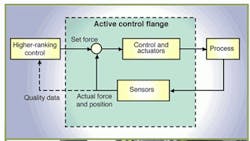Better by Design: Flange with feeling
Most robotics with tactile force feedback require extensive setup. Their response times can also introduce significant delays. Now, a touch-sensitive component from KEBA Corp., Troy, Mich., combines a sensor with pneumatic positioning and closed-loop control into one unit that automatically positions end-of-arm tools to regulate the force they exert on objects — independent of the moves made by the robot. Called the KEBA Active Contact Flange, it improves response and streamlines implementation of robotic positioning based on force, while increasing quality and productivity.
Already used in applications for Volkswagen, Neubacher, and SPS Technik, the flange is useful for precise workpiece handling in polishing, assembly, gluing, and gentle material handling and positioning.
Standalone flanges allow program logic in the IEC programming language; and communication via Ethernet, field bus, or digital I/O speeds integration into existing controls. Data on actual force, position, and contact is tracked for a comprehensive parameter log — and to eliminate separate quality controls. In contrast, when integrated into master control platforms, the flange's scalable software includes motion, process, and supervisory visualization packages. Here, compatible motors, drives, I/O, controls, and fixed and mobile HMI devices make for turnkey coordinated automation of robot kinematics and entire systems.
VITAL STATS
On display: KEBA Active Contact Flange
Key features: Independently and automatically compensates for positioning (within its 100-mm stroke envelope) to maintain constant force on work surfaces, regardless of contour. Stationary repeat accuracy is ±0.5% of maximum force; maximum overshoot at force changes is 2% (aperiodic limit case.) Inlet air, exhaust air, and control connections.
What it means to you: Allows for linear moves in the robot program while buffing curved objects; operators simply set the required force. Simplified robotic integration.
What else: Collision damage protection: The mechanical design minimizes risk of workpiece damage due to tool collisions; even during sudden interference, the system quickly reacts and gives way.
Innovator: KEBA Corp. US
(248) 526-0561
keba.com
